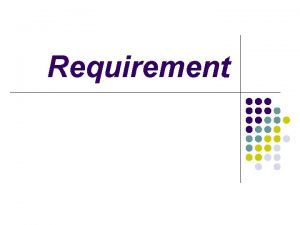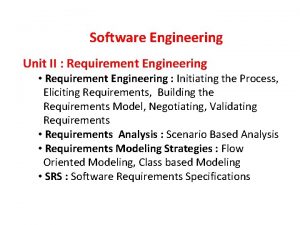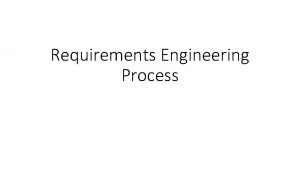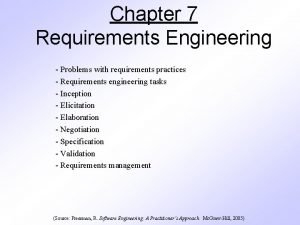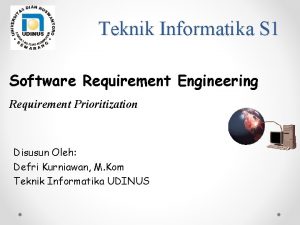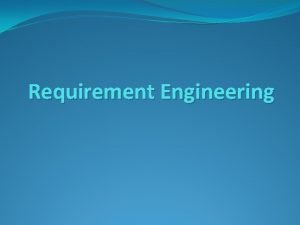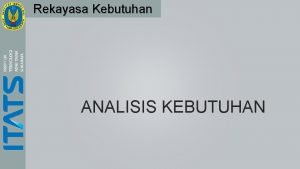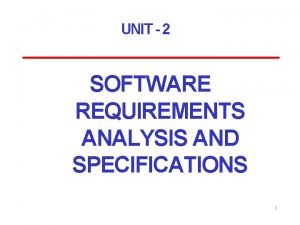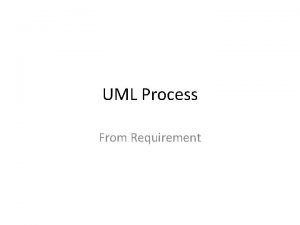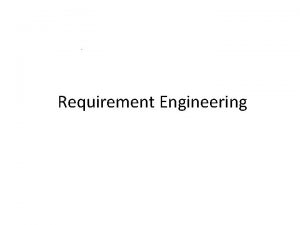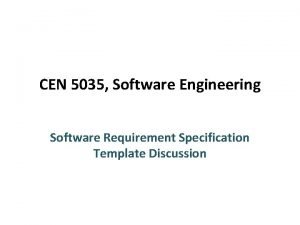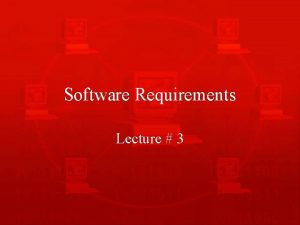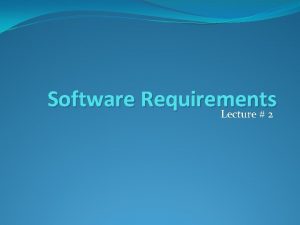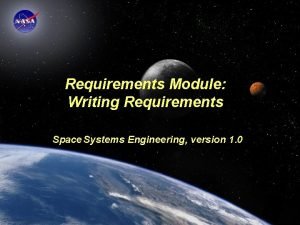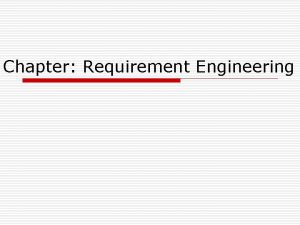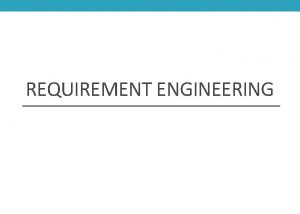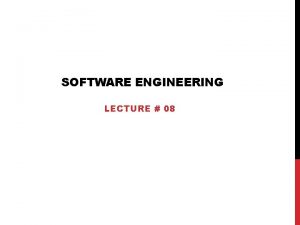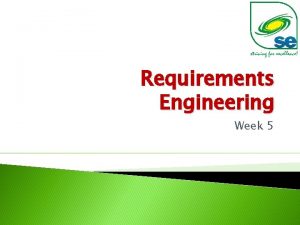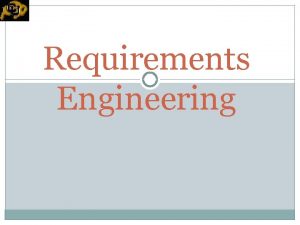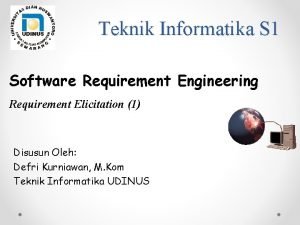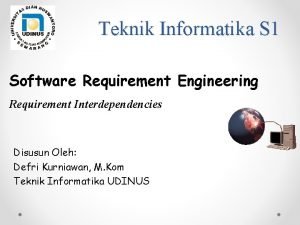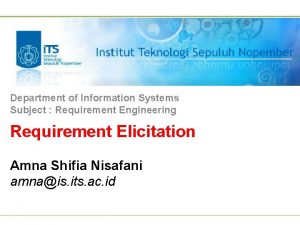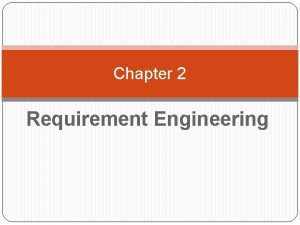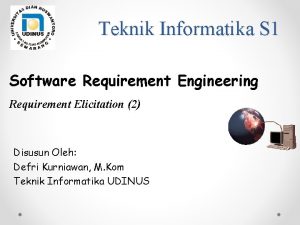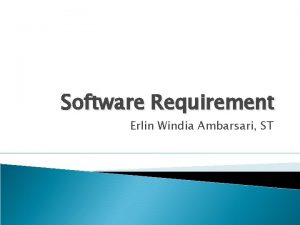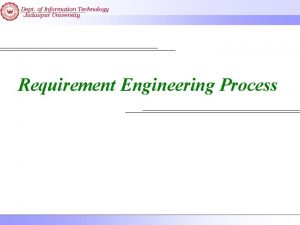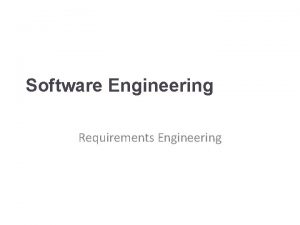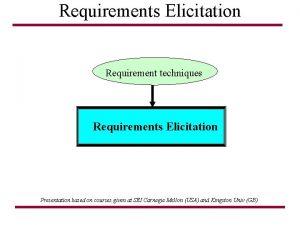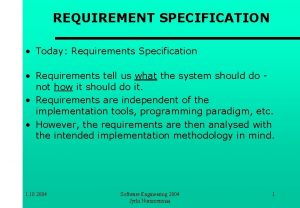Chapters 3 4 Requirements Engineering All requirement types


























- Slides: 26

Chapters 3 & 4 – Requirements Engineering All requirement types Verification Pepper modifying Sommerville's Book slides Chapter 4 Requirements engineering 1

Topics covered ² What are all types of requirements ² The software requirements document ² Requirements engineering processes ² Requirements validation ² Requirements management Chapter 4 Requirements engineering 2

User and system requirements reminder Chapter 4 Requirements engineering 3

Functional and non-functional requirements ² Functional requirements § Statements of services the system should provide, how the system should react to particular inputs and how the system should behave in particular situations. § May state what the system should not do. ² Non-functional requirements § Constraints on the services or functions offered by the system such as timing constraints, constraints on the development process, standards, etc. § Often apply to the system as a whole rather than individual features or services. ² Domain requirements § Constraints on the system from the domain of operation Chapter 4 Requirements engineering 4

Requirements completeness and consistency ² In principle, requirements should be both complete and consistent. ² Complete § They should include descriptions of all facilities required. ² Consistent § There should be no conflicts or contradictions in the descriptions of the system facilities. ² In practice, it is impossible to produce a complete and consistent requirements document. Chapter 4 Requirements engineering 5

Types of nonfunctional requirement Chapter 4 Requirements engineering 6

Non-functional requirements implementation ² Non-functional requirements may affect the overall architecture of a system rather than the individual components. § For example, to ensure that performance requirements are met, you may have to organize the system to minimize communications between components. ² A single non-functional requirement, such as a security requirement, may generate a number of related functional requirements that define system services that are required. § It may also generate requirements that restrict existing requirements. Chapter 4 Requirements engineering 7

Examples of nonfunctional requirements in the MHC-PMS Product requirement The MHC-PMS shall be available to all clinics during normal working hours (Mon–Fri, 0830– 17. 30). Downtime within normal working hours shall not exceed five seconds in any one day. Organizational requirement Users of the MHC-PMS system shall authenticate themselves using their health authority identity card. External requirement The system shall implement patient privacy provisions as set out in HStan-03 -2006 -priv. Chapter 4 Requirements engineering 8

Metrics for specifying nonfunctional requirements Property Measure Speed Processed transactions/second User/event response time Screen refresh time Size Mbytes Number of ROM chips Ease of use Training time Number of help frames Reliability Mean time to failure Probability of unavailability Rate of failure occurrence Availability Robustness Time to restart after failure Percentage of events causing failure Probability of data corruption on failure Portability Percentage of target dependent statements Number of target systems Chapter 4 Requirements engineering 9

Domain requirements ² The system’s operational domain imposes requirements on the system. § For example, a train control system has to take into account the braking characteristics in different weather conditions. ² Domain requirements be new functional requirements, constraints on existing requirements or define specific computations. ² If domain requirements are not satisfied, the system may be unworkable. ² Our systems - Finch will have domain limitations Chapter 4 Requirements engineering 10

The software requirements document ² The software requirements document is the official statement of what is required of the system developers. ² Should include both a definition of user requirements and a specification of the system requirements. ² It is NOT a design document. As far as possible, it should set of WHAT the system should do rather than HOW it should do it. Chapter 4 Requirements engineering 11

Users of a requirements document Chapter 4 Requirements engineering 12

The structure of a requirements document Chapter Description Preface This should define the expected readership of the document and describe its version history, including a rationale for the creation of a new version and a summary of the changes made in each version. Introduction This should describe the need for the system. It should briefly describe the system’s functions and explain how it will work with other systems. It should also describe how the system fits into the overall business or strategic objectives of the organization commissioning the software. Glossary This should define the technical terms used in the document. You should not make assumptions about the experience or expertise of the reader. User requirements Here, you describe the services provided for the user. The nonfunctional definition system requirements should also be described in this section. This description may use natural language, diagrams, or other notations that are understandable to customers. Product and process standards that must be followed should be specified. System architecture This chapter should present a high-level overview of the anticipated system architecture, showing the distribution of functions across system modules. Architectural components that are reused should be highlighted. Chapter 4 Requirements engineering 13

The structure of a requirements document Chapter Description System requirements specification This should describe the functional and nonfunctional requirements in more detail. If necessary, further detail may also be added to the nonfunctional requirements. Interfaces to other systems may be defined. System models This might include graphical system models showing the relationships between the system components and the system and its environment. Examples of possible models are object models, data-flow models, or semantic data models. System evolution This should describe the fundamental assumptions on which the system is based, and any anticipated changes due to hardware evolution, changing user needs, and so on. This section is useful for system designers as it may help them avoid design decisions that would constrain likely future changes to the system. Appendices These should provide detailed, specific information that is related to the application being developed; for example, hardware and database descriptions. Hardware requirements define the minimal and optimal configurations for the system. Database requirements define the logical organization of the data used by the system and the relationships between data. Index Several indexes to the document may be included. As well as a normal alphabetic index, there may be an index of diagrams, an index of functions, and so on. Chapter 4 Requirements engineering 14

A spiral view of the requirements engineering process Chapter 4 Requirements engineering 15

Problems of requirements elicitation and analysis ² Stakeholders don’t know what they really want. ² Stakeholders express requirements in their own terms. ² Different stakeholders may have conflicting requirements. ² Organisational and political factors may influence the system requirements. ² The requirements change during the analysis process. New stakeholders may emerge and the business environment may change. Chapter 4 Requirements engineering 16

The requirements elicitation and analysis process Chapter 4 Requirements engineering 17

Key points ² The software requirements document is an agreed statement of the system requirements. It should be organized so that both system customers and software developers can use it. ² The requirements engineering process is an iterative process including requirements elicitation, specification and validation. ² Requirements elicitation and analysis is an iterative process that can be represented as a spiral of activities – requirements discovery, requirements classification and organization, requirements negotiation and requirements documentation. Chapter 4 Requirements engineering 18

Stakeholders in the MHC-PMS ² Patients whose information is recorded in the system. ² Doctors who are responsible for assessing and treating patients. ² Nurses who coordinate the consultations with doctors and administer some treatments. ² Medical receptionists who manage patients’ appointments. ² IT staff who are responsible for installing and maintaining the system. Chapter 4 Requirements engineering 19

Stakeholders in the MHC-PMS ² A medical ethics manager who must ensure that the system meets current ethical guidelines for patient care. ² Health care managers who obtain management information from the system. ² Medical records staff who are responsible for ensuring that system information can be maintained and preserved, and that record keeping procedures have been properly implemented. Chapter 4 Requirements engineering 20

Methods of Eliciting Requirements ² Interview ² Scenario ² Use case ² Ethnography Chapter 4 Requirements engineering 21

Requirements checking with User ² Validity. Do requirements match customer's real needs? ² Consistency. Are there any requirements conflicts? ² Completeness. Are all functions required by the customer included? ² Realism. Can the requirements be implemented given available budget and technology ² Verifiability. Can the requirements be checked? ² How to check § Requirements reviews § Prototyping § Test-case generation Chapter 4 Requirements engineering 22

Expect and manage change to requirements ² Establishes the level of requirements management detail that is required. ² Requirements management decisions: § Requirements identification Each requirement must be uniquely identified so that it can be cross-referenced with other requirements. § A change management process This is the set of activities that assess the impact and cost of changes. I discuss this process in more detail in the following section. § Traceability policies These policies define the relationships between each requirement and between the requirements and the system design that should be recorded. § Tool support Tools that may be used range from specialist requirements management systems to spreadsheets and simple database systems. Chapter 4 Requirements engineering 23

Requirements change management ² Deciding if a requirements change should be accepted § Problem analysis and change specification • During this stage, the problem or the change proposal is analyzed to check that it is valid. This analysis is fed back to the change requestor who may respond with a more specific requirements change proposal, or decide to withdraw the request. § Change analysis and costing • The effect of the proposed change is assessed using traceability information and general knowledge of the system requirements. Once this analysis is completed, a decision is made whether or not to proceed with the requirements change. § Change implementation • The requirements document and, where necessary, the system design and implementation, are modified. Ideally, the document should be organized so that changes can be easily implemented. Chapter 4 Requirements engineering 24

Requirements change management Chapter 4 Requirements engineering 25

Summary ² Requirement Types: § Functional § Non-Functional § Domain ² Requirements Documentation § High level what, not how § Written in natural language or structured with graphs, diagrams and tables where possible § Validate document § Expect and manage changes Chapter 4 Requirements engineering 26
 Contoh system requirement
Contoh system requirement Requirement engineering
Requirement engineering Requirement engineering
Requirement engineering Requirement engineering process
Requirement engineering process Inception in requirement engineering
Inception in requirement engineering Contoh user requirement
Contoh user requirement User requirement
User requirement Requirement analysis model in software engineering
Requirement analysis model in software engineering What is inception in software engineering
What is inception in software engineering Requirement engineering adalah
Requirement engineering adalah Analisis kebutuhan pengguna
Analisis kebutuhan pengguna Software engineering lecture notes
Software engineering lecture notes Requirement analysis steps in software engineering
Requirement analysis steps in software engineering Requirement engineering
Requirement engineering Requirement analysis plan
Requirement analysis plan Elaboration in requirement engineering
Elaboration in requirement engineering Requirement engineering template
Requirement engineering template Draw three noncollinear points j k and l
Draw three noncollinear points j k and l Village by the sea chapter 2 summary
Village by the sea chapter 2 summary Solas all chapters
Solas all chapters Engineering requirements document
Engineering requirements document Inverse requirements
Inverse requirements Inverse requirements in software engineering
Inverse requirements in software engineering Form-based specifications
Form-based specifications Requirements discovery techniques in software engineering
Requirements discovery techniques in software engineering Requirements writing for system engineering
Requirements writing for system engineering Domain requirements
Domain requirements
